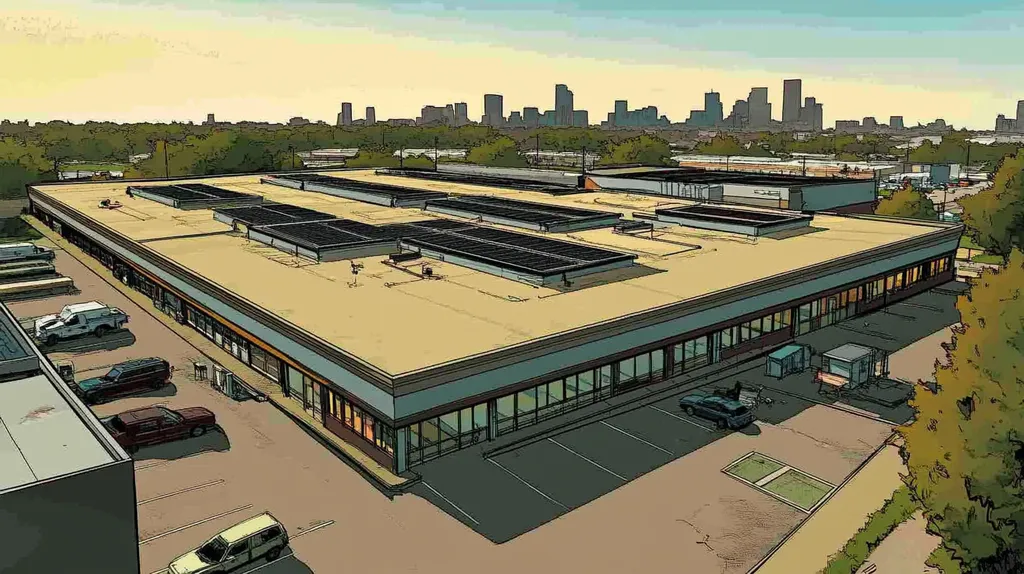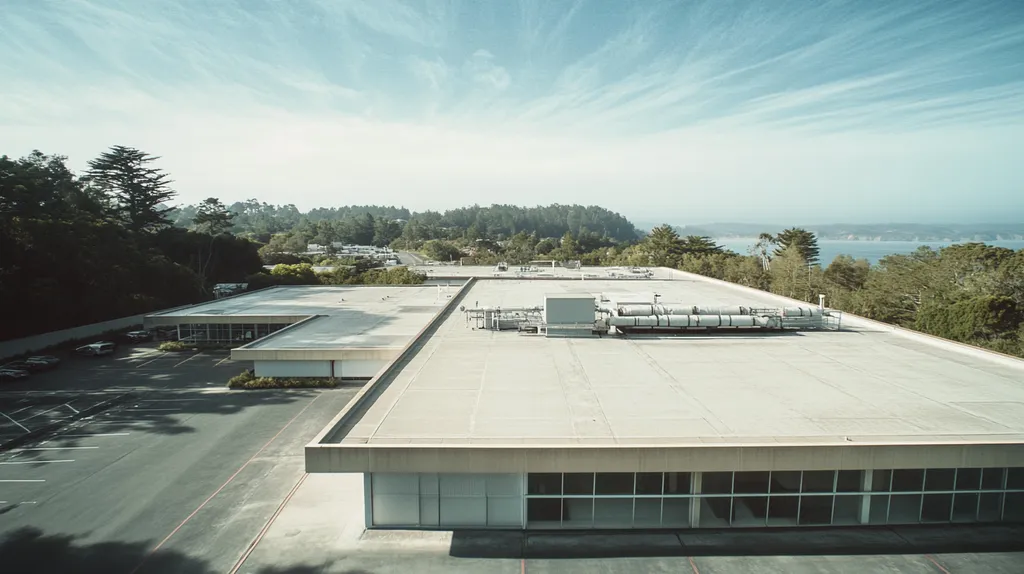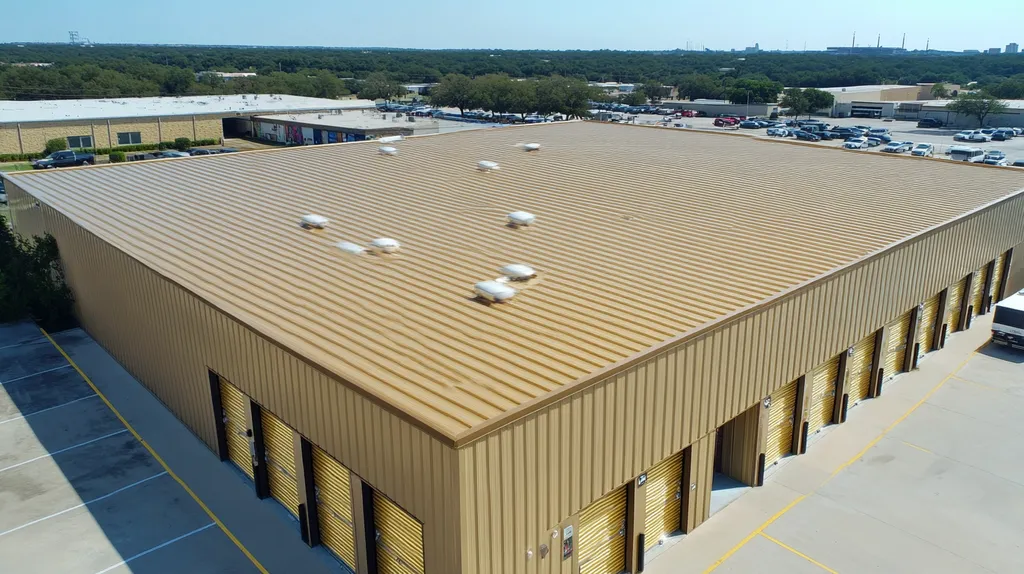In today’s industrial facilities, roof failures cost businesses an average of $1.2 million per incident in repairs, damaged equipment, and operational disruptions. Studies indicate that 85% of these costly failures could have been prevented through systematic inspection and maintenance.
With modern roofing systems becoming increasingly complex, integrating multiple components from membranes to mechanical equipment, professional inspection has evolved from a basic visual check to a comprehensive diagnostic process.
This guide breaks down the essential elements of industrial roof inspection, providing facility managers with actionable insights to protect their buildings, extend roof lifespan, and optimize maintenance investments.
SECTION 1: THE BASICS EXPLAINED
Industrial roof failures cost businesses millions each year in repairs, equipment damage, and operational disruptions. Studies show that up to 85% of these failures could have been prevented through proper inspection and maintenance. Understanding and implementing effective roof inspection practices isn’t just about protecting your building – it’s about safeguarding your entire business operation and investment.
What It Is (In Plain Language)
A roof inspection is a systematic evaluation of your industrial roof’s condition, components, and potential problem areas. Think of it as a comprehensive health check-up for your building’s first line of defense against the elements.
During an inspection, qualified professionals examine every critical component of your roofing system. This includes the membrane or surface material, seams, flashings, drainage systems, and any rooftop equipment penetrations.
Modern inspections often utilize advanced technology like infrared scanning to detect hidden moisture issues and drone photography for detailed visual documentation. These tools help create a complete picture of your roof’s condition.
The process should occur at least twice yearly – typically in spring and fall – with additional checks after severe weather events. Regular monitoring helps catch small issues before they become major problems.
Why It Matters (To Your Building)
Proper roof inspection directly impacts your facility’s operational efficiency and bottom line. Even a small leak can cascade into significant problems, from damaged inventory to compromised structural integrity.
Beyond immediate damage control, regular inspections help extend your roof’s lifespan by identifying and addressing wear patterns early. This proactive approach can add 5-10 years to your roof’s service life.
Insurance companies often require documented inspection programs. Maintaining detailed records of regular inspections can help reduce premiums and ensure coverage when you need it most.
Environmental control and energy efficiency also depend on roof condition. A well-maintained roof helps regulate interior temperatures and reduce HVAC costs throughout the year.
How It Works
A professional inspection begins with collecting basic information about your roof’s age, history, and previous maintenance records. This background helps inspectors focus on likely problem areas and track changes over time.
Keeping roofs clean and free of debris while maintaining clear, functional drainage systems forms the foundation of any inspection program. Regular cleaning prevents material degradation and ensures proper water flow. (source: Travelers Insurance)
Inspectors document their findings through detailed photography and measurements. They pay special attention to seams, flashings, and areas around rooftop equipment where leaks commonly develop.
Following the inspection, you receive a comprehensive report outlining current conditions, identifying potential problems, and recommending specific maintenance actions. This document becomes your roadmap for maintaining roof integrity and planning future investments.
SECTION 2: PRACTICAL APPLICATIONS
Industrial roof maintenance impacts far more than just building protection – it directly affects operational continuity, energy efficiency, and asset preservation. Recent industry data shows that facilities with regular inspection programs reduce their emergency repair costs by 71% compared to those practicing reactive maintenance. Understanding the practical applications of roof inspections helps facility managers maximize their return on investment while protecting critical operations.
Common Uses & Examples
Industrial roof inspections serve multiple critical functions beyond basic leak detection. They help identify structural issues like deck deflection, membrane deterioration, and failing seals before these problems compromise operations.
Modern inspection protocols increasingly focus on performance optimization. This includes evaluating insulation effectiveness, identifying opportunities for reflective coating applications, and assessing potential for green roof installations or solar panel integration.
Documentation from regular inspections provides valuable data for capital planning. Tracking degradation patterns helps facility managers predict when major repairs or replacements will be needed, allowing for better budget allocation.
Quality inspections also validate warranty compliance and strengthen insurance claims. Many manufacturers require documented inspections to maintain material warranties, while insurers often reduce premiums for facilities with proven maintenance programs.
When You Need It Most
Severe weather events demand immediate roof inspections to assess potential damage. High winds can loosen flashings and membrane materials, while hail impacts may not show visible damage but can compromise roof integrity.
Seasonal transitions require targeted inspections as temperature fluctuations stress roofing materials. Fall inspections should focus on drainage preparation for winter, while spring checks need to assess any damage from freeze-thaw cycles.
Any modifications to rooftop equipment or penetrations necessitate inspection. New HVAC installations, vent additions, or satellite dish mounting can create vulnerabilities that require proper sealing and ongoing monitoring.
Facility use changes often impact roof performance requirements. Converting warehouse space to temperature-controlled storage, for example, creates new vapor control demands that may require roofing modifications.
Interactions With Other Systems
Regular inspections must account for rooftop mechanical systems that create unique stress points. HVAC units generate vibration and condensation while requiring regular maintenance access that can damage roofing materials.
Electrical and plumbing penetrations present constant challenges for maintaining watertight seals. Expansion and contraction from temperature changes can compromise even properly installed flashings over time.
Elements in the inspection include keeping roofs clean and free of debris and ensuring drainage systems are clear and functional. Regular cleaning prevents material degradation while proper drainage helps avoid structural damage. (source: Travelers Insurance)
Lightning protection systems require special attention during inspections. Improperly secured components can puncture membranes, while deteriorated connections may compromise both roofing and electrical safety.
SECTION 3: KEY TERMINOLOGY DECODED
Clear communication can mean the difference between a minor repair and catastrophic roof failure. Studies show that misunderstandings of basic roofing terminology lead to 40% of preventable commercial roof damage. When facility managers and roofing professionals speak the same language, maintenance becomes more efficient, repairs more targeted, and budgeting more accurate.
Essential Terms Explained
The membrane serves as your roof’s primary waterproof barrier. Single-ply membranes like TPO, EPDM, and PVC offer different advantages in durability, energy efficiency, and chemical resistance.
Penetrations refer to any breaks in the roof surface for utilities, vents, or equipment. These critical points require proper flashing – the waterproof materials that seal around openings and protect against water infiltration.
Substrate describes the underlying structure supporting your roofing system. Understanding your substrate type helps determine weight limitations for equipment placement and repair options.
Drainage components including gutters, scuppers, and internal drains direct water off your roof. Proper drainage prevents ponding water, which can add dangerous weight loads and accelerate material deterioration.
Industry Jargon Translated
Built-up roofing (BUR) describes traditional tar-and-gravel systems using multiple layers of waterproof material. Modern BUR systems incorporate advanced materials for better performance and longevity.
R-value measures insulation effectiveness, with higher numbers indicating better thermal resistance. Proper insulation not only reduces energy costs but also prevents condensation that can damage roofing materials.
Uplift resistance indicates how well your roof system resists wind forces. This critical measurement helps determine if your roof meets local building codes and insurance requirements.
Ice damming occurs when melted snow refreezes at roof edges, forcing water under materials. Understanding this process helps prevent winter damage through proper insulation and ventilation.
Measurement & Units Simplified
Slope, measured in units of rise over run (like 4:12), affects drainage and material choices. Even “flat” commercial roofs require minimal slope for proper drainage.
Square footage calculations must include vertical surfaces like parapets and mechanical curbs. These often-overlooked areas can add 10-15% to material requirements.
Life-cycle cost analysis combines initial installation price with annual maintenance expenses. This calculation provides a more accurate picture of long-term roofing investments than installation costs alone.
Wind uplift ratings use pounds per square foot (psf) to measure resistance. Understanding these ratings helps ensure your roof system meets local requirements and insurance standards.
SECTION 4: DECISION FACTORS
When managing industrial roofing assets, informed decision-making can mean the difference between optimal performance and costly failures. Studies show that facilities implementing data-driven inspection strategies reduce their long-term maintenance costs by up to 40% compared to reactive approaches. Understanding key decision factors helps facility managers develop comprehensive inspection programs that protect both their buildings and bottom lines.
Cost Considerations
Initial inspection costs represent only a fraction of the total roofing investment. Quality inspections typically range from $0.10 to $0.30 per square foot, varying based on roof complexity and inspection methods used.
Hidden costs often emerge from delayed or inadequate inspections. Water infiltration can damage expensive equipment, disrupt operations, and compromise structural integrity before visible signs appear.
Regular inspections help facilities develop accurate maintenance budgets. Early detection of issues allows for planned repairs rather than emergency responses, which typically cost 300% more.
Insurance premiums often reflect inspection practices. Many carriers offer reduced rates for buildings with documented inspection programs, while some may deny claims for damages linked to negligent maintenance.
Performance Trade-offs
Inspection frequency directly impacts roof performance. While semi-annual inspections are standard, some facilities require quarterly checks based on local climate conditions and operational demands.
Advanced inspection technologies like infrared scanning can detect hidden moisture issues but add costs. However, these methods often pay for themselves by identifying problems before they cause significant damage.
Equipment installations and modifications create additional inspection requirements. Regular verification of equipment connections and waterproofing integrity helps prevent costly water infiltration.
Rust inspection on metal components, equipment curb connections, and securing cables requires particular attention during inspections to prevent water infiltration and equipment damage. (source: Disastersafety.org)
Lifespan & Durability Factors
Inspection programs significantly influence roof longevity. Buildings with regular inspections typically see their roofs last 21-30% longer than those without structured maintenance programs.
Environmental factors affect inspection requirements. Facilities in areas with extreme weather conditions or high pollution levels may need more frequent specialized inspections.
Material choices impact long-term inspection needs. While some roofing systems require minimal maintenance, others demand regular professional evaluation to maintain warranty coverage.
Documenting inspection history creates valuable data for lifecycle planning. Tracking degradation patterns helps predict when major repairs or replacements will be needed, allowing for better capital planning.
SECTION 5: COMMON CHALLENGES
Industrial roofs face increasingly complex challenges that threaten both building integrity and operational continuity. Studies show that 40% of roof failures stem from unaddressed maintenance issues, while another 35% result from improper repairs of initial problems. Understanding these challenges and implementing systematic solutions can prevent cascading failures that often result in extensive damage and costly business interruptions.
Frequent Problems & Solutions
Structural movement represents a primary concern in industrial roofing, often manifesting as cracks, bulges, and surface irregularities. These issues typically indicate underlying stress that requires immediate professional evaluation.
Moisture infiltration through compromised seams and flashings creates widespread damage, affecting both roofing materials and interior systems. Regular inspection and maintenance of these critical components can prevent most water-related failures.
Common issues include cracks, bulges, valleys, ponding water, rust and corrosion, punctures, debris, biological growth, shrinkage, and clogged drainage. Each of these problems requires specific remediation strategies to prevent escalation. (source: Procore)
Equipment-related damage often occurs around HVAC units, vents, and other rooftop installations. Implementing designated maintenance paths and proper equipment mounting solutions helps minimize this wear pattern.
Warning Signs To Watch For
Interior indicators like water stains, unusual odors, or unexplained increases in energy costs often signal developing roof problems. These symptoms require immediate investigation to prevent widespread damage.
Surface deterioration including blistering, splitting, or exposed substrate materials indicates material failure. Early detection through regular inspections can limit repair scope and costs.
Drainage system complications manifest through standing water, blocked gutters, or overflow during normal rainfall. Addressing these issues promptly prevents structural stress and membrane degradation.
Changes in roof flexibility or appearance around perimeter areas often signal underlying problems. These subtle variations require professional evaluation to determine appropriate corrective actions.
Preventative Approaches
Establishing comprehensive inspection schedules based on roof age, local climate, and usage patterns provides the foundation for effective maintenance. This systematic approach helps identify potential issues before they become critical failures.
Implementing proper traffic control measures and maintenance protocols protects vulnerable areas from unnecessary wear. Designated walkways and equipment service zones help concentrate impact in protected areas.
Regular cleaning and debris removal prevents material degradation while maintaining proper drainage function. This basic maintenance significantly extends roof life and reduces repair frequency.
Documentation of all inspections, repairs, and maintenance activities creates valuable historical data for predicting future needs. This information helps optimize maintenance scheduling and budget allocation.
SECTION 6: NEXT STEPS & RESOURCES
Industrial roof maintenance represents a significant investment that demands strategic planning and informed decision-making. Studies show that facilities implementing comprehensive inspection programs reduce their annual maintenance costs by up to 45% while extending roof life by 7-10 years. Understanding what questions to ask, which standards to follow, and where to find reliable information helps facility managers optimize their roofing investments and prevent costly failures.
Questions To Ask Providers
Start by verifying the provider’s experience with your specific roofing system and building type. Request detailed information about their inspection methodology, including whether they use advanced diagnostics like infrared scanning or core sampling.
Ask about their documentation process and reporting systems. Quality providers should offer detailed digital reports with photos, measurements, and specific recommendations for both immediate and long-term maintenance needs.
Discuss their approach to equipment inspection and how they assess critical connection points. Regular inspection of rooftop equipment mounting, flashing conditions, and potential rust development helps prevent water infiltration issues. (source: Disastersafety.org)
Request information about their quality control processes and whether they provide post-inspection maintenance recommendations. Understanding their full service scope helps ensure comprehensive roof protection.
Industry Standards & Guidelines
Familiarize yourself with ASTM D7186 guidelines for roof system inspection. This standard establishes minimum requirements for evaluation procedures and helps ensure consistent quality across inspections.
Review FM Global Property Loss Prevention Data Sheets relevant to your roof type. These documents provide valuable technical guidance for maintaining different roofing systems and addressing common failure points.
Understand local building codes and insurance requirements affecting roof maintenance. Many jurisdictions now require specific inspection protocols and documentation to maintain compliance.
Consider implementing a roof asset management program that aligns with International Organization for Standardization (ISO) guidelines. This systematic approach helps optimize maintenance investments while ensuring regulatory compliance.
Further Learning Simplified
Take advantage of educational resources offered by major roofing manufacturers. Many provide detailed technical bulletins and maintenance guides specific to their systems.
Join professional organizations like the Roof Consultants Institute (RCI) or National Roofing Contractors Association (NRCA). These groups offer valuable training programs and updated industry information.
Participate in industry webinars and online forums focused on industrial roofing. These platforms often feature case studies and practical solutions to common maintenance challenges.
Build a digital library of relevant technical documents and inspection reports. Having these resources readily available helps inform future maintenance decisions and budget planning.
The Bottom Line
With industrial roof failures costing businesses an average of $1.2 million per incident, systematic inspection programs represent a critical investment in operational continuity and asset protection.
Modern technology and comprehensive inspection protocols now enable facility managers to detect and address problems before they escalate into costly failures.
Studies consistently show that buildings with regular professional inspections extend their roof life by 21-30% while reducing annual maintenance costs by up to 45%.
By implementing the structured approach outlined in this guide, facility managers can transform their roofing program from a reactive liability into a proactive asset that protects operations, conserves resources, and optimizes long-term investment returns.
FREQUENTLY ASKED QUESTIONS
Q. What is an industrial roof inspection?
A. An industrial roof inspection is a thorough evaluation of your roof’s condition, focusing on critical components. It’s akin to a health check-up for your building, ensuring your roof securely protects against the elements. Regular inspections can prevent costly failures and extend the life of your roof.
Q. How can a commercial roof inspection save costs?
A. Investing in regular roof inspections helps identify problems early and reduces emergency repair costs by a substantial margin. By preventing leaks or structural issues, businesses can avoid disruptions and maintain smooth operations, ultimately preserving their financial resources and protecting their investments.
Q. What critical terms should I know about commercial roofs?
A. Understanding key terms like membrane, penetrations, and substrate helps you communicate effectively with roofing professionals. These terms relate to components that affect your roof’s waterproofing, structural integrity, and overall performance; knowing them can guide more informed maintenance decisions.
Q. What factors influence commercial roof inspection costs?
A. The costs of commercial roof inspections depend on the roof’s complexity, the inspection methods used, and its size. Advanced techniques like infrared scanning and the inspector’s experience can increase fees, but these costs often lead to savings by preventing future damage and extending roof lifespan.
Q. What are common issues found during industrial roof inspections?
A. Common issues during inspections include moisture infiltration, structural movement, and equipment-related wear. Other issues like ponding water, cracks, and biological growth can necessitate immediate attention to avoid further complications that could lead to costly repairs and operational disruptions.
Q. How can I optimize my roof maintenance after inspections?
A. After inspections, developing a structured maintenance plan based on documented findings is essential. This plan should include scheduled repairs, routine cleaning, and proactive monitoring of problem areas, utilizing the inspection report as a roadmap for strategic capital planning.
Q. What are important questions to ask roof inspection providers?
A. When selecting a roof inspection provider, inquire about their experience with your roof type, the inspection methods they employ, and their documentation practices. Additionally, discuss their approach to equipment inspections and how they ensure comprehensive reports that include actionable maintenance recommendations.










